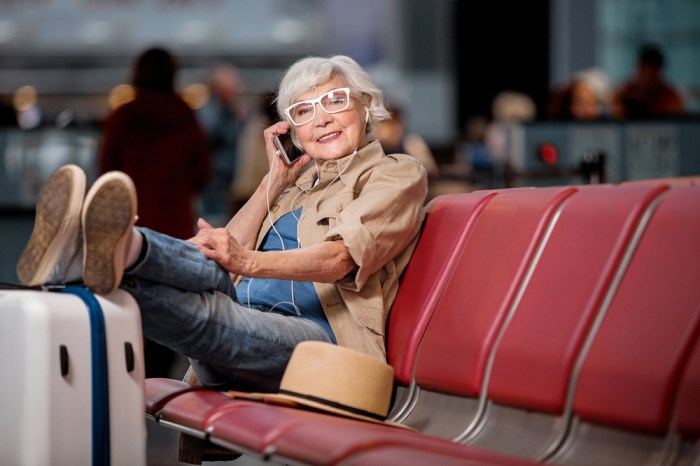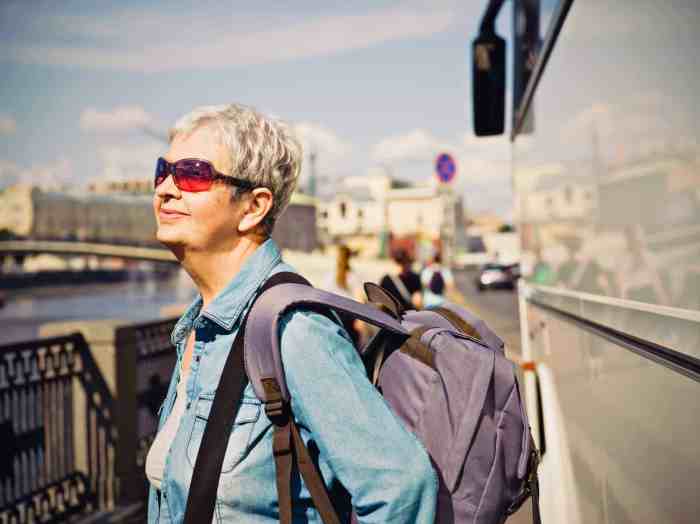Seniors Traveling Alone: The allure of independent adventure beckons many older adults, promising freedom and self-discovery. However, solo travel for seniors presents unique challenges and considerations, from safety concerns and logistical planning to health and financial matters. This guide navigates the complexities of senior solo travel, offering practical advice and strategies to ensure a safe, enriching, and memorable experience.
This comprehensive resource addresses key aspects of planning and executing a successful solo trip for seniors, covering everything from pre-trip preparations like travel insurance and itinerary sharing to on-the-ground strategies for staying safe and healthy in unfamiliar environments. We explore various transportation options, suitable accommodation choices, and ways to combat loneliness and maintain well-being throughout the journey. Budgeting, financial management, and accessible destination selection are also thoroughly examined, empowering seniors to confidently embark on their independent adventures.
Safety and Security Concerns for Solo Senior Travelers

International travel offers unparalleled opportunities for personal enrichment, but for senior citizens venturing out alone, heightened safety awareness is paramount. The independence and freedom of solo travel must be balanced with a proactive approach to mitigating potential risks inherent in unfamiliar environments. This requires careful planning, informed decision-making, and a commitment to personal safety strategies.
Common Safety Concerns for International Solo Senior Travel
Seniors traveling alone face unique challenges. Physical limitations, potential health vulnerabilities, and unfamiliarity with local customs and languages increase their susceptibility to various risks. These include petty theft, scams targeting tourists, medical emergencies in remote locations, and difficulties navigating unfamiliar transportation systems. The risk of becoming disoriented or lost is also significantly higher for solo travelers, particularly in densely populated or linguistically challenging areas.
Furthermore, age-related cognitive decline can make it harder to react quickly to potentially dangerous situations.
Strategies for Staying Safe in Unfamiliar Environments
Proactive safety measures are crucial. Before departure, research the destination thoroughly, focusing on areas known for safety and security. Register with the relevant embassy or consulate and share travel plans with family or friends. Upon arrival, learn basic local phrases and familiarize yourself with local emergency numbers. Avoid walking alone at night in poorly lit or isolated areas.
Use reputable transportation services and be wary of unsolicited offers of assistance. Maintain situational awareness, keeping valuables secure and avoiding ostentatious displays of wealth. Carry copies of essential documents and keep them separate from originals. It is advisable to make photocopies of your passport and other important documents and store them separately from the originals. Consider purchasing travel insurance that includes medical evacuation coverage.
Essential Safety Apps and Gadgets for Solo Senior Travelers
Utilizing technology can significantly enhance safety. Several apps and gadgets offer valuable features designed specifically for solo travelers.
| App Name | Description | Platform Compatibility | Cost |
|---|---|---|---|
| ICE (In Case of Emergency) | Allows you to store emergency contact information accessible even when your phone is locked. | iOS, Android | Free |
| BSafe | Provides a panic button feature that alerts pre-selected contacts with your location. | iOS, Android | Free (with premium options) |
| Guardian Angel | Offers real-time location tracking and allows for check-ins with loved ones. | iOS, Android | Subscription-based |
| Personal Locator Beacon (PLB) | Sends a distress signal to emergency services, even in areas with limited cellular coverage. | N/A (standalone device) | Varies by model |
Sharing Travel Itineraries and Location Updates
Regular communication with loved ones is vital. Share a detailed itinerary including flight numbers, accommodation details, and planned activities. Utilize location-sharing features on apps like Google Maps or Find My Friends to allow family and friends to track your progress in real-time. Schedule regular check-in calls or texts, especially if traveling to remote areas. Consider setting up automated location updates at predetermined intervals.
These measures provide peace of mind for both the traveler and their loved ones, fostering a sense of security throughout the journey.
Planning and Logistics for Independent Senior Travel: Seniors Traveling Alone

Planning a solo trip as a senior citizen requires meticulous attention to detail, ensuring a safe, comfortable, and enriching experience. This involves careful consideration of various logistical aspects, from booking flights and accommodations to selecting appropriate destinations and crafting a realistic itinerary. Thorough preparation minimizes stress and maximizes enjoyment, allowing for a truly fulfilling independent adventure.
Step-by-Step Guide for Planning a Solo Trip
Effective trip planning begins with defining the scope of the journey. Factors such as budget, desired travel duration, and personal mobility influence the selection of destinations and activities. Next, a tentative itinerary is developed, outlining daily activities and potential transportation needs. This itinerary should be flexible to accommodate unexpected circumstances or spontaneous opportunities. Booking flights and accommodations should be completed well in advance, especially during peak seasons, to secure favorable rates and preferred options.
Finally, confirming travel insurance and making necessary visa or passport arrangements completes the pre-trip preparations. Regularly reviewing and updating the itinerary as needed is crucial for a smooth travel experience.
Choosing Accessible and Senior-Friendly Destinations
Selecting a destination that caters to the needs and preferences of senior travelers is paramount. Factors such as accessibility of transportation, availability of senior-friendly accommodations, and ease of navigation within the destination should be carefully considered. Destinations with good healthcare infrastructure and emergency services are also highly desirable. Cities with well-maintained walkways, accessible public transport, and a slower pace of life often prove ideal.
Examples include towns in the Cotswolds (UK), smaller cities in Italy like Siena or Assisi, or coastal towns in Portugal. These locations generally offer a balance of cultural richness, historical significance, and ease of navigation, minimizing physical strain on the traveler.
Sample Itinerary: 7-Day Solo Trip to Lisbon, Portugal
This itinerary assumes a moderate level of mobility and interest in history, culture, and food. Lisbon’s relatively flat terrain and extensive public transportation system make it accessible for many seniors.
| Day | Activity | Transportation |
|---|---|---|
| 1 | Arrival in Lisbon, check into hotel near the city center. Afternoon stroll through Alfama district. | Taxi from airport. |
| 2 | Morning: Jerónimos Monastery and Belém Tower. Afternoon: Pastéis de Belém (custard tarts). | Tram 15 to Belém. |
| 3 | Day trip to Sintra: Pena Palace and Quinta da Regaleira. | Train from Rossio Station. |
| 4 | Explore the Baixa district, ride the Santa Justa Lift, visit São Jorge Castle. | Walking and Lift. |
| 5 | Visit a Fado show in the evening. Afternoon: explore LX Factory, a trendy industrial area. | Tram and Taxi/Uber. |
| 6 | Relaxing morning, souvenir shopping, enjoy a final Portuguese meal. | Walking. |
| 7 | Departure from Lisbon. | Taxi to airport. |
Advantages and Disadvantages of Travel Booking Platforms for Seniors
Several online travel agencies (OTAs) cater to travelers’ needs. Each platform offers distinct advantages and disadvantages for senior travelers. For example, Booking.com and Expedia offer extensive choices but may lack personalized assistance for specific senior needs. Specialized senior travel agencies often provide tailored support and accessible travel options, but their offerings may be more limited. Direct booking with hotels or airlines can sometimes provide better value but requires more effort in researching and comparing options.
The ideal platform depends on individual preferences and technical proficiency. Seniors comfortable with technology may find OTAs convenient, while those preferring personalized service might opt for a specialized agency. Carefully weighing the pros and cons of each option ensures a suitable booking experience.
Health and Wellness Considerations for Solo Senior Travelers
Embarking on solo travel as a senior presents unique opportunities for personal growth and exploration, but it also necessitates a proactive approach to health and wellness. Prioritizing health and safety ensures a fulfilling and worry-free experience. This section details crucial considerations for maintaining well-being while traveling independently.
Travel Insurance and Medical Preparedness
Comprehensive travel insurance is paramount for solo senior travelers. Policies should cover medical emergencies, evacuations, and repatriation, acknowledging the heightened risks associated with age and potential health complications while abroad. Consider policies offering 24/7 emergency assistance services, including access to medical professionals and translators. Before departure, consult your physician to discuss any potential health concerns, obtain necessary vaccinations, and acquire any required prescriptions.
A detailed medical history, including allergies and existing conditions, should accompany your travel documents. This proactive approach minimizes potential disruptions and ensures access to appropriate care if needed.
Essential Medications and Medical Supplies
Packing a comprehensive medical kit is crucial. This should include all prescribed medications with sufficient quantities to cover the entire trip, plus a few extra days’ worth in case of delays. Include copies of prescriptions and a list of medications with dosages. The kit should also contain over-the-counter remedies for common ailments like pain relievers, anti-diarrheal medication, antiseptic wipes, bandages, motion sickness remedies, and any personal medical devices.
A thermometer, a first-aid manual, and any personal assistive devices are also essential components. Consider consulting a pharmacist or your doctor to ensure your kit is complete and appropriate for your destination and itinerary.
Maintaining Physical Fitness and Mental Well-being
Solo travel can be physically and mentally demanding. Maintaining fitness and well-being is vital for a positive experience. Prior to travel, engage in regular physical activity to build stamina and endurance. During the trip, incorporate light exercise into your daily routine, such as walking tours or utilizing hotel fitness facilities. Prioritize sleep, maintain a healthy diet, and stay hydrated.
To combat loneliness, engage in social activities, such as joining local tours or striking up conversations with fellow travelers. Packing familiar comfort items, such as a favorite book or music, can also help maintain mental well-being. Remember to schedule downtime and avoid over-scheduling your itinerary to prevent burnout.
Accessing Healthcare Services in Unfamiliar Locations
Knowing how to access healthcare services in a foreign country is critical. Before departure, research local healthcare systems and emergency numbers. Consider purchasing an international medical assistance card or obtaining information about reciprocal healthcare agreements between your home country and your destination. Pack a list of local doctors or hospitals in your chosen destinations, along with contact information.
Familiarize yourself with the local language, or at least learn basic medical terminology, to aid communication. Many hotels can provide assistance with locating nearby medical facilities, and your travel insurance provider should be able to offer guidance and support if needed. In case of emergencies, always seek immediate medical attention.
Budgeting and Financial Planning for Solo Senior Travel
Planning a financially sound solo trip as a senior requires careful consideration of various factors, from accommodation choices to unforeseen expenses. A well-structured budget, combined with smart financial management strategies, ensures a worry-free and enjoyable travel experience. This section details practical approaches to budgeting and managing finances for solo senior travelers.
Sample Budget for a Week-Long Solo Trip, Seniors Traveling Alone
This example Artikels a budget for a week-long trip to a mid-range destination like Portland, Oregon, adjusting for individual preferences and destinations is crucial. Prices are estimates and may vary depending on the season and specific choices.
| Expense Category | Estimated Cost (USD) |
|---|---|
| Accommodation (7 nights, mid-range hotel/Airbnb) | $700 |
| Transportation (flights, local transport) | $500 |
| Food (mix of restaurants and groceries) | $350 |
| Activities (museums, tours, etc.) | $250 |
| Miscellaneous (souvenirs, tips, etc.) | $100 |
| Total Estimated Cost | $1900 |
Managing Finances While Traveling
Several methods facilitate secure and efficient financial management during travel. Credit cards offer convenience and purchase protection, but responsible use is essential to avoid accumulating high interest charges. Travel money cards, pre-loaded with funds in local currency, provide a secure alternative to carrying large amounts of cash. They also often offer better exchange rates than using credit cards directly for international transactions.
It’s advisable to inform your bank and credit card companies of your travel plans to prevent any issues with card usage. Consider setting daily spending limits and regularly checking your account balances to maintain awareness of expenses.
Finding Affordable Accommodations and Activities
Seniors can access numerous cost-effective travel options. Consider staying in budget-friendly accommodations like hostels (many offer private rooms), guesthouses, or Airbnb rentals outside of the city center. Look for deals and discounts on travel websites and consider off-season travel for lower prices on flights and accommodations. Many museums and attractions offer senior discounts, so always inquire about potential savings.
Free activities such as walking tours, exploring parks, and visiting free museums or historical sites are excellent ways to experience a destination without breaking the bank.
Tracking Expenses and Staying Within Budget
Maintaining a detailed record of expenses is vital for staying within budget. Utilize a travel journal, spreadsheet, or budgeting app to meticulously track all spending. Categorize expenses (accommodation, food, transportation, etc.) for better understanding of spending patterns. Regularly review your expenses against your budget to identify potential overspending areas. This proactive approach allows for necessary adjustments throughout the trip, ensuring you remain within your financial limits.
Consider setting a daily spending limit and sticking to it.
Embarking on a solo journey as a senior is a testament to a spirit of adventure and independence. While planning and preparation are crucial, the rewards of exploring the world on your own terms are immeasurable. By carefully considering the safety, logistical, health, and financial aspects detailed in this guide, seniors can confidently plan and enjoy fulfilling solo travel experiences, creating lasting memories and enriching their lives.

